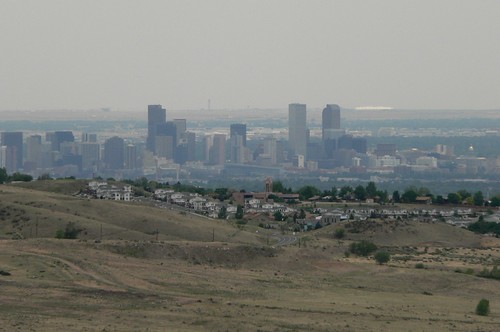美國科羅拉多州博爾德國家大氣研究中心(NCAR)的科學家用全世界運算能力最強的電腦之一計算出,全美到了2050年夏季,有害臭氧的濃度將升高70%。
「不管你在美國何處,氣候變遷都可能影響空氣品質。暖化的地球不只是氣溫升高,夏季汙染和健康威脅也將隨之而來。」研究主要作者,NCAR科學家Gabriele Pfister說。
儘管全球持續暖化 仍需控制排放 減緩臭氧汙染
溫度上升、大氣中的甲烷含量升高,以及其他氣候變遷影響,都將促進地表臭氧形成的化學反應。
為了瞭解氣候變遷對臭氧汙染的影響,Pfister和其研究團隊檢視了兩種假設情況,兩種情況都假設溫室氣體持續排放,且暖化程度顯著,但第一種是讓來自人類活動的氮氧化物和揮發性有機化合物維持目前的排放量,直到2050年;第二種則是減少排放量60~70%。
研究發現,如果臭氧前驅物排放量不減,到了2050年,全美臭氧濃度超過75ppb的8小時區間數,平均將增加70%。相反的,Pfister和研究團隊發現,若氮氧化物和揮發性有機化合物大幅減少,即使氣候變暖,也可以緩解臭氧汙染。
美環署擬嚴訂有害臭氧值
8小時75ppb是美國環保署認定的有害臭氧閾值。目前環保署正在考慮訂定得更嚴苛,改為8小時65~70ppb。
整體來說,NCAR研究預測2050年時,臭氧濃度將有90%以上的時間介於30~87ppb之間,而目前落在31~79ppb之間。雖然挪移範圍並不大,結果仍顯示超越安全值的天數大幅增加了。
在第二個假設情境下,氮氧化物和揮發性有機化合物排放量減少60~70%時,則有90%的時間臭氧濃度介於27~55ppb。臭氧濃度超出有害值的8小時區間數減少至小目前的1%。
NCAR科學家解釋,臭氧濃度隨氣候變遷增加的背後有3個原因:
- 高溫下大氣中形成臭氧的化學反應增加。
- 高溫下植物排放出更多的揮發性有機化合物,和人類造成的汙染物質混和後,增加臭氧生成機會。
- 大氣中濃度越來越高的甲烷導致全球臭氧增加,並將提高全美的地表臭氧濃度基線。
地表臭氧來自人為碳排 引發哮喘、損壞作物
地表臭氧是大氣煙霧的主要成分,他們並非直接被排放到大氣中,而是氮氧化物和揮發性有機化合物在陽光下產生化學反應而來。
氮氧化物和揮發性有機化合物等氣體,又被稱為「臭氧前驅物」,主要來自於煤炭和石油燃燒等人類活動,以及植物等天然排放源。
平流層的臭氧能幫助地球阻擋來自太陽的紫外線輻射,但地表臭氧可能引起哮喘、支氣管炎和肺氣腫等健康問題。即使是短時間暴露於有害臭氧濃度,也能導致地方死亡率升高。此外,臭氧汙染也損壞作物和其他植物。
Americans across the country face a 70 percent increase in unhealthy summertime ozone levels by 2050, find scientists at the National Center for Atmospheric Research in Boulder working with one of the world’s most powerful computers.
This is because warmer temperatures, higher atmospheric levels of methane, and other atmospheric impacts of a changing climate, spur chemical reactions that form ground-level ozone.
“It doesn’t matter where you are in the United States – climate change has the potential to make your air worse,” said NCAR scientist Gabriele Pfister, lead author of the new study. “A warming planet doesn’t just mean rising temperatures, it also means risking more summertime pollution and the health impacts that come with it.”
On the other hand, Pfister and her colleagues found that sharp reductions the emission of nitrogen oxides and volatile organic compounds could reduce ozone pollution even as the climate warms.
Ground level ozone, a major constituent of atmospheric smog, is not emitted directly, but forms as a result of chemical reactions that take place between nitrogen oxides and volatile organic compounds in the presence of sunlight.
These gases, called ozone precursors, come from human activities such as combustion of coal and oil as well as natural sources such as emissions from plants.
Unlike ozone in the stratosphere, which benefits life on Earth by blocking ultraviolet radiation from the Sun, ground-level ozone can trigger health problems such as asthma, bronchitis, and emphysema. Even short periods of unhealthy ozone levels can cause local death rates to rise.
Ozone pollution also damages crops and other plants.
To examine the impacts of climate change on ozone pollution, Pfister and her colleagues looked at two scenarios. In one, emissions of nitrogen oxides and volatile organic compounds from human activities would continue at current levels through 2050. In the other, emissions would be cut by 60-70 percent.
Both scenarios assumed continued greenhouse gas emissions with significant warming.
The researchers found that, if emissions continue at present-day rates, the number of eight-hour periods in which ozone would exceed 75 parts per billion would jump by 70 percent on average across the United States by 2050.
The 75 ppb level over eight hours is the threshold that is considered unhealthy by the U.S. Environmental Protection Agency. The agency is considering tightening the ozone standard to a value between 65 and 70 ppb over eight hours.
Overall, the NCAR study found that, 90 percent of the time, ozone levels would range from 30 to 87 ppb in 2050 compared with an estimated 31 to 79 ppb in the present.
Although the range itself shifts only slightly, the result is a much larger number of days above the threshold now considered unhealthy, Pfister explained.
For the second scenario, emissions of nitrogen oxides and volatile organic compounds would be cut by 60-70 percent.
Then, 90 percent of the time, ozone levels would range from 27 to 55 ppb. The number of instances when ozone pollution would exceed the unhealthy level of 75 ppb dropped to less than one percent of current cases.
Ozone levels increase with with climate change for three main reasons, the NCAR scientists explain.
First, chemical reactions in the atmosphere that produce ozone occur more rapidly at higher temperatures.
In addition, plants emit more volatile organic compounds at higher temperatures, which can increase ozone formation if mixed with pollutants from human sources.
Also, methane, which is increasing in the atmosphere, contributes to increased ozone globally and will enhance baseline levels of surface ozone across the United States.
※ 全文及圖片詳見:ENS








